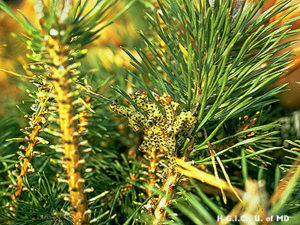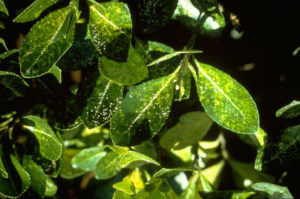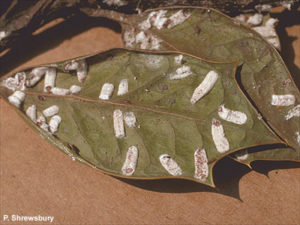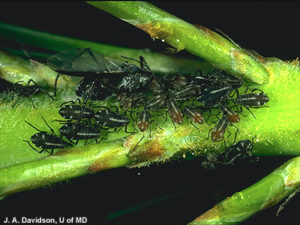Your landscape is bound to face plant pest problems eventually, so it’s best to be prepared and learn as much about them as possible! It’s only natural for plants to experience diseases and damage from insects, but most plants have one pest in particular that can cause extreme harm. Continue reading to learn about the steps to diagnose pest problems.

Many insects have coloring similar to their host.
Observe
Try to observe your landscape daily and get to know what your plants look like when they’re healthy so you’ll notice any problems right away.
Know Your Plants
Some types of plants are particularly susceptible to certain pests or disease problems.
Are The Leaves Eaten
The pest might be an insect, slug or animal. Large holes in the middle of the leaf can indicate beetles, caterpillars, and slugs. Shredded foliage or plants eaten right down to the ground might be the work of an animal, such as a deer or woodchuck.
Are The Leaves Discolored

Some insects are very small.
If so, how? Silvery, bronzed or stippled foliage may indicate the presence of sucking insects such as aphids, mites, and lace bugs. Pale or mottled leaves can indicate an environmental or nutrition problem.
Are There Spots On The Leaves
They may be caused by a disease. But they can also be the result of insect feeding or environmental factors. Some plants are notorious for their susceptibility to certain diseases.
Look For Insects And Fungal Signs

Some insects hide on the underside of leaves.
Do you see insects, eggs or droppings? Some insects are difficult to see but they leave telltale signs. Some insects are so well camouflaged you may not see them, but you may be able to identify them by their droppings. Be sure to look on the stems and underside of leaves.
Insects you see may not be causing the symptoms. Ants, for example, are sometimes found on damaged plants and are assumed to be causing the problem. But they generally don’t harm plants — they’re after the honeydew (a sugary secretion) left by the real pests, usually aphids. Other insects, such as lacewing or ladybug larvae are beneficial insects that may already be working to control the real pests.
Other Signs And Symptoms
Examine plants for anything out of place. Some pests are so small you’re unlikely to see them, but on close inspection, you may see signs of their presence. For example, spider mites are smaller than a pinhead but reveal their presence with the silky webbing they produce. Though slugs feed at night and usually hide during the day, the shiny slime trails they leave behind are telltale “footprints.”
Is Treatment Required

Aphids suck the sap from susceptible plants.
If it is the end of the growing season, control may not be warranted. If it’s early in the season and the plant is at risk, you may need to act quickly. Diseases pose different challenges. Most products that control diseases are preventative. They won’t cure a disease but can keep it from spreading. You may also be able to keep a disease problem in check by removing and destroying affected leaves or parts of the plant.
Call In A Professional
As you can see, there are many steps to properly diagnosing a plant pest problem. A trained professional Plant Health Care Advisor can diagnose the problem and develop a treatment plan.
Scientific Plant Service Is Your Go-To Source In Landscape Healthcare
Scientific Plant Service, located in Baltimore, is a privately-owned corporation, chartered in Maryland in 1957 by Frank J. Burke. We started as a full-service Arborist specializing in the care of shade trees and ornamental shrubs, but today we are a lawn and total landscape care company that is a huge part of the community. From aquatic environments and snow management to deer and mole control, SPS has services tailored specifically for your lawn and landscape.
We offer services in Maryland, Washington DC, and Virginia, including Harford, Baltimore, Carroll, Frederick, Howard, Anne Arundel, Montgomery, Prince Georges, Talbot, Queen Anne’s, and Calvert counties in MD, as well as Loudoun County, Fairfax County, Arlington, Alexandria, and Falls Church in VA. For more information, contact us online, or call us at 410-321-0970. Be sure to follow us on Facebook, Twitter, LinkedIn, and Pinterest!

